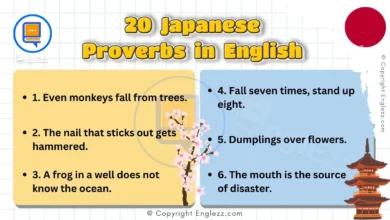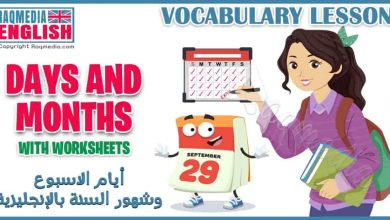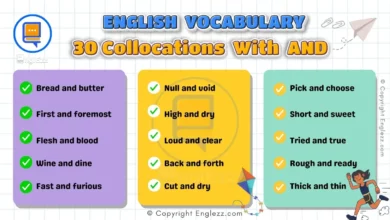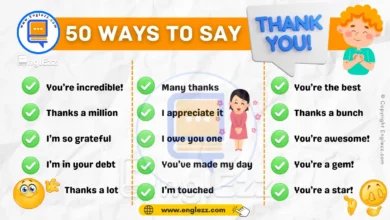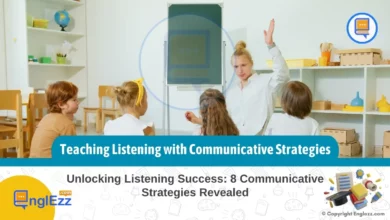Understanding literature can be a daunting task, especially when faced with the rich array of terminology used by scholars and critics. Whether you’re diving into a classic novel, analyzing a poem, or studying for your next exam, a solid grasp of essential literature terms is crucial for interpreting and appreciating literary works. This blog post covers 50 literature English terms every student must know, providing clear definitions, phonetic transcriptions, and practical examples to help you enhance your literary analysis skills.
50 Literature English Terms Every Student Must Know
By familiarizing yourself with these terms, you’ll not only boost your academic performance but also gain deeper insights into the texts you encounter. From “alliteration” to “zeitgeist,” each term will be explored to give you a comprehensive understanding of its usage and significance.
Let’s embark on this literary journey and enrich your vocabulary with terms that will elevate your reading and writing prowess.
#1. Allegory 🧩
- Definition: A narrative in which characters, events, and settings symbolize abstract ideas and concepts, often conveying a moral or philosophical message.
- Phonetic Transcription: /ˈælɪɡəri/
- Examples:
- George Orwell’s Animal Farm is an allegory for the Russian Revolution.
- John Bunyan’s The Pilgrim’s Progress uses allegory to explore Christian themes.
#2. Alliteration 📝
- Definition: The repetition of initial consonant sounds in closely positioned words.
- Phonetic Transcription: /əˌlɪtəˈreɪʃən/
- Examples:
- “She sells seashells by the seashore.”
- “Peter Piper picked a peck of pickled peppers.”
#3. Antagonist 😈
- Definition: The character or force in a story that opposes the protagonist, creating conflict.
- Phonetic Transcription: /ænˈtæɡənɪst/
- Examples:
- In Macbeth, Macbeth’s ambition serves as his antagonist.
- Voldemort is the antagonist in J.K. Rowling’s Harry Potter series.
#4. Archetype 🔮
- Definition: A typical character, action, or situation that represents universal patterns of human nature.
- Phonetic Transcription: /ˈɑrkɪtaɪp/
- Examples:
- The hero’s journey is an archetype seen in The Odyssey.
- The wise old man, like Gandalf in The Lord of the Rings, is an archetype.
#5. Assonance 🎵
- Definition: The repetition of vowel sounds within closely placed words.
- Phonetic Transcription: /ˈæsənəns/
- Examples:
- “The rain in Spain stays mainly in the plain.”
- “Hear the mellow wedding bells.”
#6. Cliché 💬
- Definition: An overused expression or idea that has lost its original meaning or impact.
- Phonetic Transcription: /kliːˈʃeɪ/
- Examples:
- “Time heals all wounds” is a cliché often seen in literature.
- “Better late than never” is a commonly used cliché.
#7. Conflict ⚔️
- Definition: The struggle between opposing forces in a story, driving the plot forward.
- Phonetic Transcription: /ˈkɒnflɪkt/
- Examples:
- The central conflict in Romeo and Juliet is the feud between their families.
- In To Kill a Mockingbird, the conflict arises from racial injustice.
#8. Connotation 🌟
- Definition: The implied or suggested meaning of a word or phrase, beyond its literal definition.
- Phonetic Transcription: /ˌkɒnəˈteɪʃən/
- Examples:
- “Home” connotes warmth and security beyond its definition as a place of residence.
- “Slim” connotes attractiveness, while “skinny” may have a negative connotation.
#9. Denotation 📖
- Definition: The literal or dictionary meaning of a word or phrase.
- Phonetic Transcription: /ˌdiːnoʊˈteɪʃən/
- Examples:
- The denotation of “rose” is a type of flowering plant.
- “Bird” denotes a feathered creature capable of flight.
#10. Dialogue 🗣️
- Definition: The conversation between characters in a literary work.
- Phonetic Transcription: /ˈdaɪəlɒɡ/
- Examples:
- The dialogue between Hamlet and Ophelia reveals their troubled relationship.
- In Pride and Prejudice, dialogue reveals social class and character traits.
#11. Dramatic Irony 🎭
- Definition: A situation in a play or story where the audience knows something that the characters do not.
- Phonetic Transcription: /drəˈmætɪk ˈaɪrəni/
- Examples:
- In Oedipus Rex, the audience knows Oedipus is the murderer before he does.
- Shakespeare’s Romeo and Juliet contains dramatic irony in the characters’ misunderstanding of Juliet’s sleep.
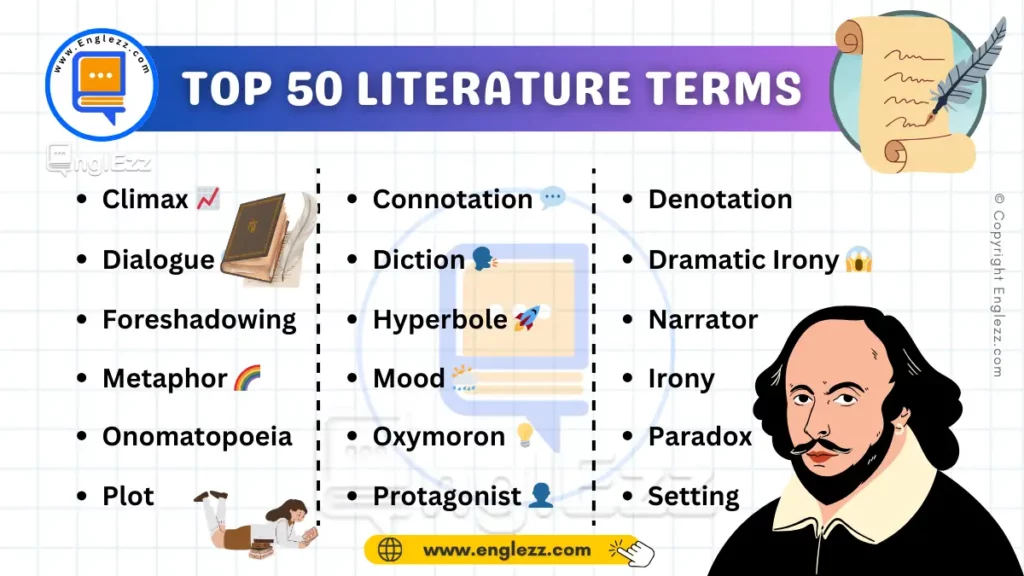
#12. Foil 🎭
- Definition: A character who contrasts with another character, usually the protagonist, to highlight particular qualities.
- Phonetic Transcription: /fɔɪl/
- Examples:
- Dr. Watson is a foil to Sherlock Holmes in Arthur Conan Doyle’s stories.
- In Harry Potter, Draco Malfoy acts as a foil to Harry Potter.
#13. Foreshadowing 🔮
- Definition: A literary device used to give hints or clues about what will happen later in the story.
- Phonetic Transcription: /fɔːrˈʃæd.oʊ.ɪŋ/
- Examples:
- In Romeo and Juliet, Romeo’s premonition of his death foreshadows the tragic end.
- The storm in Macbeth foreshadows the turmoil and chaos to come.
#14. Hyperbole 💥
- Definition: Exaggerated statements or claims not meant to be taken literally.
- Phonetic Transcription: /haɪˈpɜːrbəli/
- Examples:
- “I’ve told you a million times” is a common hyperbole.
- “He’s as strong as an ox” uses hyperbole to emphasize strength.
#15. Imagery 🌅
- Definition: Descriptive language used to create vivid mental pictures and appeal to the senses.
- Phonetic Transcription: /ˈɪmədʒəri/
- Examples:
- “The golden sun dipped below the horizon, painting the sky with hues of orange and pink.”
- “The aroma of freshly baked bread wafted through the air.”
#16. Irony 🤔
- Definition: A literary device where there is a discrepancy between appearance and reality, or between what is expected and what actually happens.
- Phonetic Transcription: /ˈaɪrəni/
- Examples:
- A fire station burns down, which is ironic given its purpose.
- In The Gift of the Magi, the couple’s gifts are ironic because they are both useless.
#17. Metaphor 🔥
- Definition: A figure of speech that describes an object or action as something other than what it literally is, for rhetorical effect.
- Phonetic Transcription: /ˈmɛtəˌfɔr/
- Examples:
- “Time is a thief” is a metaphor suggesting time steals moments.
- “He’s a night owl” implies someone stays up late.
#18. Mood 😌
- Definition: The emotional atmosphere created by a literary work, influencing how the reader feels.
- Phonetic Transcription: /muːd/
- Examples:
- The mood of Edgar Allan Poe’s The Raven is dark and melancholic.
- Pride and Prejudice often carries a light, witty mood.
#19. Motif 🎨
- Definition: A recurring element that has symbolic significance in a story.
- Phonetic Transcription: /məʊˈtiːf/
- Examples:
- The recurring motif of blindness in King Lear symbolizes lack of insight.
- The motif of the green light in The Great Gatsby represents Gatsby’s unreachable dreams.
#20. Narrator 🗒️
- Definition: The voice or character who tells the story.
- Phonetic Transcription: /ˈnærətər/
- Examples:
- In The Catcher in the Rye, Holden Caulfield is the first-person narrator.
- Moby-Dick is narrated by Ishmael, providing a unique perspective on the events.
#21. Onomatopoeia 🐝
- Definition: The use of words that imitate the sound they represent.
- Phonetic Transcription: /ˌɒnəˌmætəˈpiːə/
- Examples:
- Words like “buzz” and “clang” are examples of onomatopoeia.
- “The splash of the water” mimics the actual sound.
#22. Oxymoron 💡
- Definition: A combination of contradictory or incongruent words (e.g., “deafening silence”).
- Phonetic Transcription: /ˌɒksɪˈmɔːrɒn/
- Examples:
- “Bittersweet” combines opposing feelings.
- “Jumbo shrimp” contrasts size and type.
#23. Paradox 🔄
- Definition: A statement that appears self-contradictory but reveals a deeper truth.
- Phonetic Transcription: /ˈpærədɒks/
- Examples:
- “Less is more” challenges the notion that quantity equals quality.
- “This statement is false” creates a paradoxical loop.
#24. Plot 🗺️
- Definition: The sequence of events and actions that make up a story.
- Phonetic Transcription: /plɒt/
- Examples:
- The plot of The Odyssey follows Odysseus’s journey home.
- In Jane Eyre, the plot revolves around Jane’s struggles and growth.
#25. Protagonist 👤
- Definition: The main character around whom the story revolves.
- Phonetic Transcription: /prəˈtæɡənɪst/
- Examples:
- Harry Potter is the protagonist in J.K. Rowling’s series.
- Elizabeth Bennet is the protagonist in Pride and Prejudice.
#26. Setting 🏡
- Definition: The time and place in which a story occurs.
- Phonetic Transcription: /ˈsɛtɪŋ/
- Examples:
- The setting of Wuthering Heights is the Yorkshire moors in the 18th century.
- The Great Gatsby is set in the Roaring Twenties in New York.
#27. Simile 🌈
- Definition: A figure of speech that compares two different things using “like” or “as.”
- Phonetic Transcription: /ˈsɪmɪli/
- Examples:
- “Her smile was like sunshine” compares a smile to sunlight.
- “He was as brave as a lion” uses a simile to describe bravery.
#28. Symbolism 🌟
- Definition: The use of symbols to represent ideas or qualities.
- Phonetic Transcription: /ˌsɪmbəˈlɪzəm/
- Examples:
- The white dove symbolizes peace.
- In The Lord of the Rings, the One Ring symbolizes power and corruption.
#29. Theme 🎯
- Definition: The central idea or underlying message of a literary work.
- Phonetic Transcription: /θiːm/
- Examples:
- The theme of love and sacrifice is prominent in Romeo and Juliet.
- 1984 explores themes of surveillance and totalitarianism.
#30. Tone 🎶
- Definition: The author’s attitude toward the subject or audience, conveyed through writing style and word choice.
- Phonetic Transcription: /toʊn/
- Examples:
- The tone of Moby-Dick is often somber and reflective.
- The Hitchhiker’s Guide to the Galaxy has a humorous and satirical tone.
#31. Tragedy 😢
- Definition: A dramatic work that depicts serious and important events with an unhappy ending.
- Phonetic Transcription: /ˈtrædʒədi/
- Examples:
- Shakespeare’s Hamlet is a classic example of a tragedy.
- Othello is another tragedy by Shakespeare involving themes of jealousy and betrayal.
#32. Understatement 😶
- Definition: The presentation of something as less significant than it is, often for ironic effect.
- Phonetic Transcription: /ˈʌndərˌsteɪtmənt/
- Examples:
- Saying “It’s just a scratch” when referring to a large dent.
- “The test was a bit challenging” when it was actually very difficult.
#33. Utopia 🌍
- Definition: An imagined perfect society or place, often used in literature to critique current societal conditions.
- Phonetic Transcription: /juːˈtoʊpiə/
- Examples:
- Utopia by Thomas More describes an ideal society.
- In The Giver, the community strives for a utopian existence.
#34. Dystopia 🌌
- Definition: An imagined world or society where everything is unpleasant or bad, often used to criticize real-world issues.
- Phonetic Transcription: /dɪsˈtoʊpiə/
- Examples:
- 1984 presents a dystopian future controlled by a totalitarian regime.
- The Hunger Games depicts a dystopian society where the government oppresses its citizens.
#35. Stream of Consciousness 🧠
- Definition: A narrative technique that presents the flow of a character’s thoughts and feelings as they occur.
- Phonetic Transcription: /striːm ʌv ˈkɒnʃəsnəs/
- Examples:
- James Joyce’s Ulysses uses stream of consciousness to depict thoughts.
- Virginia Woolf’s Mrs. Dalloway explores characters’ internal experiences.
#36. Symbol 🕊️
- Definition: An object, character, or event that represents a deeper meaning beyond its literal sense.
- Phonetic Transcription: /ˈsɪmbəl/
- Examples:
- The green light in The Great Gatsby symbolizes Gatsby’s unreachable dreams.
- The mockingbird in To Kill a Mockingbird represents innocence.
#37. Soliloquy 🎤
- Definition: A speech in a play where a character speaks their thoughts aloud while alone or regardless of any hearers.
- Phonetic Transcription: /səˈlɪləkwɪ/
- Examples:
- Hamlet’s “To be or not to be” soliloquy reveals his internal conflict.
- Macbeth’s soliloquy in Act 1, Scene 7, explores his doubts about murder.
#38. Flashback ⏳
- Definition: A scene set in a time earlier than the main story, used to provide background or context.
- Phonetic Transcription: /ˈflæʃbæk/
- Examples:
- In The Great Gatsby, flashbacks reveal Gatsby’s past.
- In Beloved, flashbacks detail Sethe’s traumatic experiences.
#39. Juxtaposition ⚖️
- Definition: The placement of two elements side by side to highlight their differences or similarities.
- Phonetic Transcription: /ˌdʒʌkstəpəˈzɪʃən/
- Examples:
- In A Tale of Two Cities, Dickens uses juxtaposition to compare Paris and London.
- The contrasting settings in Wuthering Heights highlight the differences between the two households.
#40. Epithet 🏷️
- Definition: A descriptive phrase or adjective used to characterize a person or thing.
- Phonetic Transcription: /ˈɛpɪˌθɛt/
- Examples:
- Alexander the Great is known for his epithet that signifies his achievements.
- In The Iliad, Achilles is often referred to as “swift-footed Achilles.”
#41. Allusion 🕵️
- Definition: A reference to another work of literature, person, or event outside the text.
- Phonetic Transcription: /əˈluːʒən/
- Examples:
- Shakespeare often alludes to classical mythology in his plays.
- In The Catcher in the Rye, Holden alludes to Robert Burns’s poem.
#42. Parody 🎭
- Definition: A humorous or satirical imitation of a serious piece of literature or writing.
- Phonetic Transcription: /ˈpærədi/
- Examples:
- Don Quixote parodies the chivalric romances of its time.
- The Simpsons often parodies various literary genres.
#43. Satire 📰
- Definition: A literary work that uses humor, irony, or ridicule to criticize or mock societal issues or individuals.
- Phonetic Transcription: /ˈsætaɪər/
- Examples:
- Jonathan Swift’s A Modest Proposal is a famous satire on British policy.
- Animal Farm uses satire to critique totalitarian regimes.
#44. Ambiguity 🌀
- Definition: The quality of being open to more than one interpretation; uncertainty.
- Phonetic Transcription: /ˌæmbɪˈɡjuːɪti/
- Examples:
- The ending of The Scarlet Letter is ambiguous, leaving readers to question Hester’s fate.
- The multiple meanings of “The Catcher in the Rye” reflect its thematic ambiguity.
#45. Motif 🎨
- Definition: A recurring theme or element in a literary work that has symbolic significance.
- Phonetic Transcription: /məʊˈtiːf/
- Examples:
- The recurring motif of eyes in The Great Gatsby represents the theme of surveillance.
- The motif of the green light symbolizes Gatsby’s unattainable dreams.
#46. Symbolism 🌟
- Definition: The use of symbols to represent ideas and concepts.
- Phonetic Transcription: /ˌsɪmbəˈlɪzəm/
- Examples:
- In Lord of the Flies, the conch shell symbolizes civilization and order.
- The white whale in Moby-Dick symbolizes the unattainable.
#47. Elegy 🕯️
- Definition: A poem or song written in honor of someone deceased, reflecting on their life and loss.
- Phonetic Transcription: /ˈɛlɪdʒi/
- Examples:
- “Lycidas” by John Milton is an elegy mourning the death of a friend.
- In Memoriam by Alfred Lord Tennyson is an elegy for Tennyson’s close friend Arthur Hallam.
#48. Lyric Poem 🎵
- Definition: A short poem expressing personal thoughts and feelings, typically in a musical or rhythmic manner.
- Phonetic Transcription: /ˈlɪrɪk/
- Examples:
- William Wordsworth’s “I Wandered Lonely as a Cloud” is a lyric poem about nature.
- Emily Dickinson’s poems often reflect her personal emotions and experiences.
#49. Rhyme Scheme 📜
- Definition: The pattern of rhyming words at the end of lines in a poem.
- Phonetic Transcription: /raɪm skiːm/
- Examples:
- The rhyme scheme of a Shakespearean sonnet is ABABCDCDEFEFGG.
- In “Twinkle, Twinkle, Little Star,” the rhyme scheme is AABB.
#50. Verisimilitude 🌍
- Definition: The appearance of being true or real within a literary work.
- Phonetic Transcription: /ˌvɛrɪsɪˈmɪlɪtjuːd/
- Examples:
- The detailed descriptions in The Lord of the Rings add verisimilitude to the fantasy world.
- Historical novels often use real events and figures to create verisimilitude.
Unlock the essentials of literary analysis with our guide to 50 crucial English terms every student must know. Dive into definitions, examples, and more to enhance your literary skills. Follow and like @EnglEzz for more educational content! Explore here: https://www.EnglEzz.com/literature-terms 📚✨ #englezz #vocabulary #linguistics #literature #education #studenttips #reading #analysis #literaryterms
Literature English Terms Table
| Allegory 📖 | Alliteration ✨ | Ambiguity 🌀 |
| Allusion 🕵️ | Anaphora 🔄 | Analogy ⚖️ |
| Antagonist 😈 | Apostrophe 📜 | Archetype 🌟 |
| Assonance 🎵 | Bildungsroman 📚 | Cliché 🧩 |
| Climax 📈 | Connotation 💬 | Denotation 📌 |
| Dialogue 💬 | Diction 🗣️ | Dramatic Irony 😱 |
| Foreshadowing 🔮 | Hyperbole 🚀 | Irony 😅 |
| Metaphor 🌈 | Mood 🌦️ | Narrator 🗣️ |
| Onomatopoeia 🐦 | Oxymoron 💡 | Paradox 🔄 |
| Plot 🗺️ | Protagonist 👤 | Setting 🏡 |
Conclusion
Mastering literature English terms is essential for any student striving to excel in literary analysis and appreciation. By familiarizing yourself with these 50 key terms, you’ll be well-equipped to navigate and interpret a wide range of literary texts, from classic novels to contemporary works.
Understanding terms such as “allegory,” “alliteration,” and “metaphor” will enhance your ability to dissect and discuss literature effectively, whether in academic settings or casual discussions. Each term explored in this post is a building block in your literary toolkit, providing the foundation for deeper comprehension and critical analysis.
As you continue to engage with literature, keep these terms in mind and apply them to enrich your reading experience. Embrace the complexities of literary language, and let these terms guide you through the fascinating world of literature. Happy reading!


